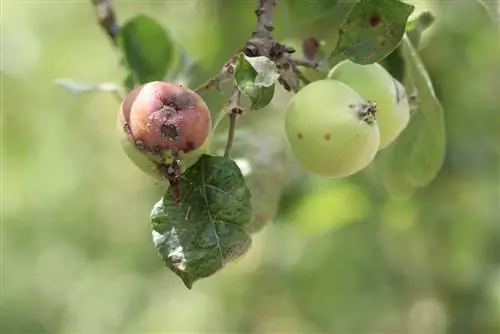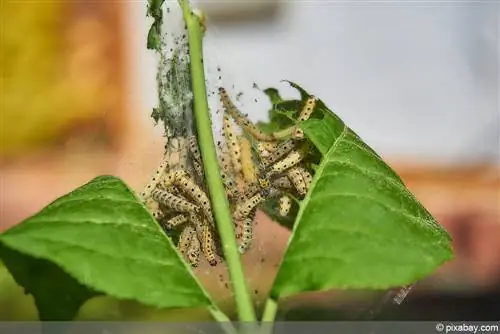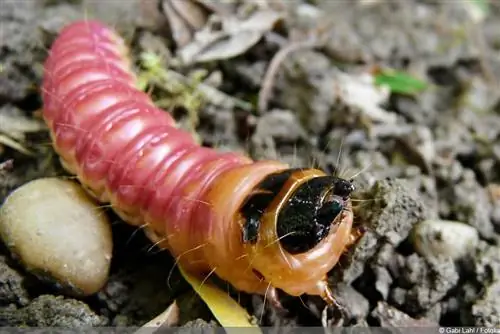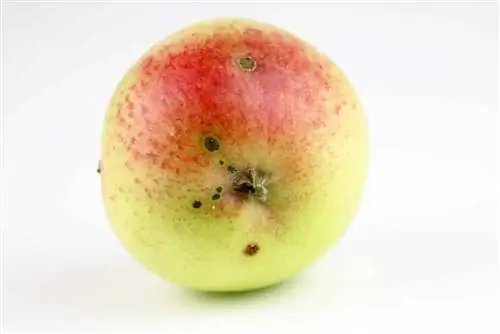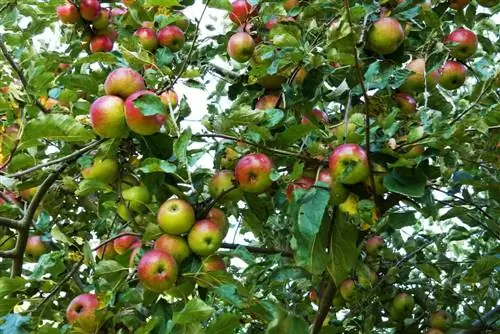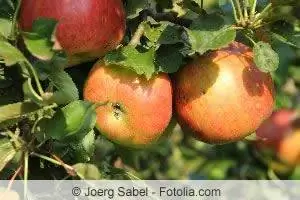- Author admin [email protected].
- Public 2023-12-17 03:39.
- Last modified 2025-01-24 12:45.
We know flawless apples from the supermarket. You think that the apple from your own tree should emulate this ideal of beauty, but no, it shouldn't. Smaller, dark spots on the outside or brown spots in the flesh are considered damage to the apple, but their causes do not have to be addressed immediately and they do not affect enjoyment.
Other pests such as aphids should be combated, if possible using natural means. Chemical sprays ultimately end up in the apple and are often harmful to the natural enemies of the insects being controlled. Treatment often also includes excision. So, don't forget to check the apple tree at regular intervals for pest or disease infestation.
Diseases
Apple trees can be affected by a wide variety of diseases. Stronger and older trees usually survive quite well, even if the treatment often requires deep cuts. However, individual diseases can lead to the death of the tree.
Glassiness
You can tell whether the apple tree is suffering from this metabolic disease by looking at the apples. If they have watery, translucent flesh below the peel in places, the tree suffers from glassiness. The causes of the disease are excessive fertilization, excessive shoot growth after severe pruning or poor nutrient supply. Countermeasures include an adequate water supply and balanced fertilization.
Stippling or speckiness
If the apple has brownish spots in the flesh, this is a sign of the speck. The cause of the disease is often a calcium deficiency. Although the brown spots are harmless for consumption, countermeasures should still be taken. These include:
- Calcium fertilization
- Switch to summer cut
- Make sure there is sufficient water supply
Tree or fruit tree cancer
Old fruit trees mostly suffer from tree cancer. The disease cannot be cured, it can only be limited. Symptoms appear on the trunk and thick branches. Orange or brown, dry and cracked areas can then be found in the bark area. After years, thick tumors and bumps also appear, which get bigger from year to year. In addition, very deep cracks can also occur.
Young trees rarely get sick. In their case, the cancer can affect the entire trunk, resulting in the death of the tree.
Treatment of the tree:
- Cut out affected areas down to the he althy wood
- Cut off small branches
- Provide wound closure with wound closure
- Dispose of cut wood immediately or burn it
Firebrand
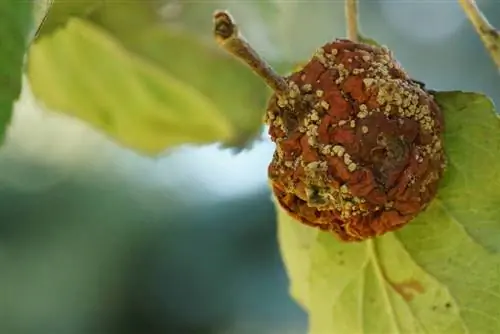
Fire blight is not a disease, but rather a dangerous disease in pome fruit crops that must be reported. Depending on the age of the tree, it leads to death more or less quickly. The disease is harmless to humans.
License plates are:
- Leaves, flowers and shoots turn black or brown
- Shoot tips curve downwards
- All parts of the plant look burned
Pruning back to the he althy wood to around 50 centimeters can help the tree. This extreme pruning is not possible for small trees; they must be completely cleared. The responsible Ministry of Agriculture provides information about the use of and which sprays.
Fire blight is spread by the transport of plants, plant material, by wind, rain, by insects, small mammals, people and birds.
Fungal diseases
Fungals and fungal diseases spread very quickly. They also don't stop at neighboring trees. If a fungal infestation is discovered, countermeasures must be taken immediately. In general, an airy and light crown helps against fungal diseases because the leaves can dry better after long periods of rain.
Tip:
Close the wounds of the apple tree with wound wax so that no further spores can penetrate the tree.
Apple scab
Apple scab occurs in strong heat and high humidity. The fungus attacks leaves and fruits.
Marks on leaves:
- Small, brown spots in spring
- Spot size increases
- Mushroom grass on the underside of the leaves
License on the apple:
- Small, dark spots on the apple, but they do no harm to it
- Partial star-shaped cracks
As a countermeasure, cutting out the tree is sufficient.
Monilia fruit rot
Brown rotten fruit mummies with white mold spots are the damage caused by Monilia fruit rot. The countermeasure is to collect the dead fruits and remove them during winter pruning, as the spores overwinter in the fruit mummies. If they are not removed with winter pruning or individually, fruit rot will set in again next year.
Soot spot disease
With sooty spot disease, the apples are covered with a soot-like layer. The surface color ranges from olive green to black. Although it can be washed off for consumption, the apples can no longer be stored. A light and airy tree crown also helps against this fungal disease so that moisture cannot stay in the tree for too long.
Calice rot
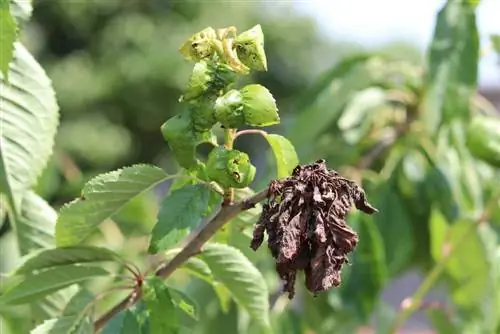
Dark brown and dry rotten spots in the calyx area are the damage caused by calyx rot. In order to contain the fungus, you don't have to resort to chemical treatment immediately. As a rule, it is sufficient if the affected parts of the tree are removed and disposed of, but not composted.
Collar Rot
The hallmarks of these fungal diseases are small fruits, reddish leaves and dark-colored bark. The tree also loses its vigor. The affected areas must be cut out immediately and sealed with wound wax. If the infestation is very severe, the tree can no longer be saved.
Tip:
Prevent waterlogging in the root area.
Mildew
Mildew leads to reduced foliage and flower development and, as a result, smaller fruits. Powdery mildew covers the tips of leaves and shoots with a white, powdery coating. The leaves dry up and eventually fall off. If you continually remove thin branches and infected branches, the fungus will be contained and eventually disappear.
Tip:
When buying the apple tree, pay attention to the variety. Some apple varieties, such as Jonathan, are more susceptible to powdery mildew than others.
Pests
Pests mainly attack the apple tree in spring and summer. The first signs of a pest usually appear in the leaves. Curling, discoloration or holes indicate a pest infestation. Therefore, the apple tree should be checked regularly for pests so that control can begin as early as possible. Pests don't only occur in spring, there are also those that use the apple tree as a breeding ground for their offspring. The uninvited guests are often laid down in autumn and, after overwintering, eat young shoots, leaf and flower buds.
Rust mites or apple rust mites
The rust mite sits on fruits and leaves of the apple tree. Characteristics are a brownish or rust-colored, round discoloration of the undersides of the leaves and the development of colorless fruits. Rust mites overwinter on the leaf buds of the apple tree and begin sucking the leaves in spring. As a rule, the damage is limited, so the use of chemical agents can be avoided.
The natural enemy of the rust mite is the predatory mite. It can be established if the infestation is very severe. In any case, infected branches should be removed to limit the spread. As a preventative measure, winter prunings should not be composted or burned near the apple tree.
Fruit tree spider mite
The fruit tree spider mite causes light spots on the leaves. Before the leaves finally fall off, a pale yellow to reddish mold forms on the leaves. On the underside of the leaves you can find fine spider threads and the yellowish red mites.
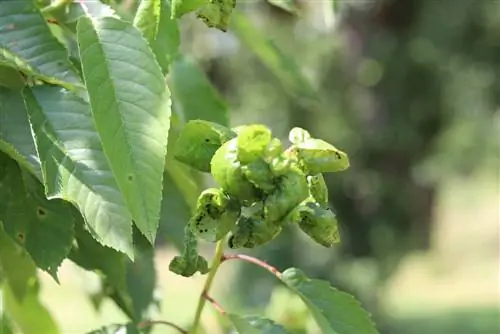
The fruit tree spider mite, like the rust mite, should be controlled with natural enemies. These are ladybugs, lacewings and spiders. Caution: The use of special chemical agents also combats the mite's natural enemies.
apple bug
The offspring of the apple bug attacks the shoot tips of the leaves. The adults suck on the leaves of the apple tree. Many small, torn holes are the damage caused by the apple bug. The leaves get brown spots and the young shoots stop growing.
The fruits have corky spots when infested, but these do not affect the taste or storage life. Insecticides are only used in severe infestations. The animals can also be shaken off early in the morning. This limits the infestation.
codling moth
The codling moth is a butterfly. Its larvae or caterpillars love to eat apples. The butterfly itself flies from May to September. It lays its eggs on the leaves or fruits of the apple tree. After one to two weeks, the voracious offspring hatch. Holes in the apples are a sign of infestation. The caterpillars eat a spiral tunnel that extends to the core. After around four weeks, the caterpillars leave the apples and nest in a well-hidden place.
If you don't want to use insecticides, you can cover thicker branches with corrugated cardboard. The larvae use them as a hiding place and can be collected underneath. Natural enemies of the codling moth are parasitic wasps or the earwig and of course birds of all kinds.
Frost tensioner
The butterfly lays its eggs in the bark cracks on the trunk of the apple tree in autumn. The larvae then eat leaf buds, flowers and leaves in spring. This goes so far that the affected parts dry out and fall off. After pupation, the young butterflies emerge in October. Natural enemies are beetles, spiders and birds. If the infestation is too severe, only an insecticide for sucking or biting insects will help against the infestation.
Tip:
Since the young larvae have to crawl up from the trunk, they can be stopped with a ring of glue. The females can also be stopped with one.
Orbit moth or apple tree moth
The actual pest of the web moth are the grey-yellow, black-spotted caterpillars. They live in webs on the apple tree and feed on the leaves. If nothing is done to combat the infestation, the entire tree will be covered in webs and completely bare by the caterpillars.
The butterflies are light and have black-dotted wings. They hatch in July and August and lay their eggs in September. Natural enemies are birds and parasitic wasps. The only thing that helps against the caterpillars and their web is to remove them, as early and generously as possible.
Apple Blossom Picker
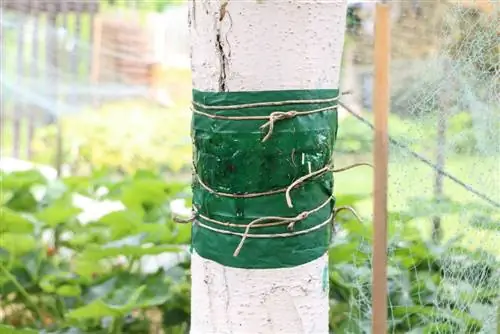
The weevil loves the flowers and fruits of the apple tree. Its winter quarters are forest areas. That's why it's mostly found in gardens near forests. Red-brown discoloration is a sign of pest infestation.
Natural enemies of the beetle are songbirds. If they fail, it must be combated with chemical agents. To avoid its spread, infected flowers should be removed immediately.
Apple sawfly
Like the codling moth, apple sawflies also see the apple tree as a suitable nursery. The wasps fly during the flowering period. Their larvae eat the apple from the inside. Eventually he falls off. If it remains on the tree, a corked area with yellow-brown discoloration will form under the shell.
Countermeasures are:
- Attach white boards with glue to the trees to prevent wasps
- Immediately remove and destroy apples with holes
- Use special chemical agents against the larvae
Apple wrinkle aphid and green apple aphid
Aphids suck out the leaves of the apple tree. They also suck on young shoots and the two-tips, i.e. everything that is young and juicy.
Control measures are:
- Hose generously with a soft soap solution
- Wash carefully with the garden hose, use a sharp jet of water
- Cut off affected branches and shoots
- If the infestation is very severe: use chemical agents
Natural enemies are ladybugs and other insects. To settle these in your garden, we recommend an insect hotel near the apple tree.
Mealy apple aphid
This aphid can cause great damage to shoots, leaves and fruits. Characteristics are curled leaves that harbor entire colonies of lice. The result of the infestation is small, stunted fruits. That's why apple trees should be checked for apple aphids shortly before they bloom.
Control measures are:
- Remove infected parts of the tree
- Thinning out a tree
- Ensure good ventilation
- Fertilize to strengthen the tree
- Chemical agents from specialist retailers
Conclusion
Although the list of diseases and pests of the apple tree is long, the gardener should be relaxed about nature. If the natural balance in the garden is right, many pests are destroyed by their natural enemies. You can help out a bit in a natural way with insect hotels or nesting boxes for birds. The chemical club should be seen as the last solution. It harms the pests, but also their natural enemies. And the poison ultimately ends up in the apple.

